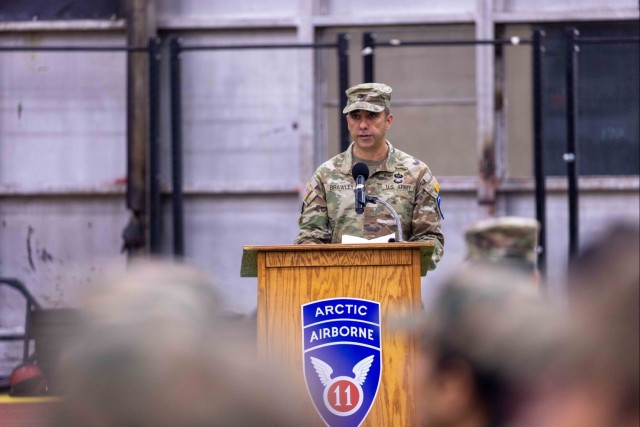FORT WAINWRIGHT, Alaska — Soldiers from the U.S. Army's 11th Airborne Division and Indian Army officially opened Exercise Yudh Abhyas 2025 during a ceremony at Fort Wainwright, Alaska, Sept. 2, marking the start of two weeks of combined training designed to enhance interoperability, readiness, and cooperation between the two nations’ land forces.
The bilateral exercise, now in its 18th iteration, will take place Sept. 1–14 at Fort Wainwright, the Yukon Training Area and Donnelly Training Area, Alaska. Sponsored by U.S. Army Pacific Command, Yudh Abhyas 25 includes U.S. Army Soldiers, primarily from the 1st Battalion, 5th Infantry Regiment “Bobcats,” 1st Infantry Brigade Combat Team (Arctic) and a comparable Indian Army contingent of the 65th Infantry Brigade.
“Together, we sharpen our skills for peacekeeping, humanitarian response and combat operations because we know that the challenges of the future will demand cooperation across borders,” said Col. Christopher Brawley, commander of the 1st Infantry Brigade Combat Team (Arctic), 11th Airborne Division. “When our soldiers trained side by side, we demonstrate to the world that our partnership is strong, enduring and prepared to meet any challenge.”

Yudh Abhyas, which means “Preparing for War” in Hindi, began in 2004 as a counterinsurgency training exchange. Over the years, it has evolved to include brigade-level command post exercises and field training exercises focused on conventional, unconventional and hybrid threats, as well as humanitarian assistance and disaster relief.
This year’s exercise includes a brigade combat team command post exercise linked with a bilateral field training exercise. Training events will incorporate artillery live-fire exercises, academic exchanges, cultural events and combined tactical operations in Alaska’s challenging terrain and climate.
The exercise’s objectives include enhancing bilateral readiness and interoperability, developing coordination between brigade and battalion staffs, integrating operational enablers, and refining air-to-ground integration doctrine. It also supports U.S. Indo-Pacific Command’s strategy to strengthen regional partnerships and maintain a free and open Indo-Pacific.
“Exercises such as Yudh Abhyas create the ideal environment to test concepts, refined procedures and most importantly, learn from each other's experience,” said Brigadier Rajiv Sahara, commander of the Indian Army, 65th Infantry Brigade. “I thank our American hosts as the partnership continues to be invaluable to us.”

Since its inception, Yudh Abhyas has expanded beyond its original counterinsurgency focus to address modern challenges faced by both nations’ militaries. Recent iterations have included training in high-altitude environments, humanitarian operations, and joint responses to crises such as natural disasters.
The exercise also provides opportunities for cultural exchange, sporting events, and professional development workshops. U.S. and Indian soldiers will work together in planning, execution, and after-action review phases, building mutual understanding and trust at all levels.
Yudh Abhyas alternates annually between India and the United States. This year the exercise is held in the United States, and next year’s iteration is scheduled to return to India.
For the United States, Alaska offers a strategically significant training ground due to its proximity to key Arctic and Indo-Pacific air and sea corridors. For Indian soldiers, it provides a venue to train in cold-weather conditions with U.S. forces experienced in Arctic operations.
The exercise supports U.S. Army Pacific’s five main priorities: campaigning, transformation, lethality, partnerships, and people. It also reflects the broader U.S.-India Major Defense Partnership, which includes a series of joint exercises, defense trade initiatives, and personnel exchanges aimed at enhancing combined capabilities.








Social Sharing